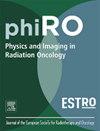Spot-optimization reduces beam delivery time in liver breath hold intensity modulated proton therapy
IF 3.3
Q2 ONCOLOGY
引用次数: 0
Abstract
Background and purpose
Liver irradiations with intensity-modulated proton therapy (IMPT) often require motion mitigation techniques that prolong treatment. A prototype spot-optimization algorithm was tested to evaluate whether plan delivery time could be reduced while preserving quality.
Methods and materials
Fifteen patients previously treated with liver IMPT using breath-hold were re-planned with nominal treatment planning system (TPS) settings and using a prototype spot-optimization algorithm in which combinations of minimum Monitor Unit (MU) and layer-spacing settings were tested: 1MU/1MeV, 3MU/3MeV, 1MU/5MeV, 5MU/3MeV. Spot-optimized and nominals plans were compared using standard dose-volume histogram (DVH) metrics for targets and organs-at-risk. A Wilcoxon signed-rank test was applied (p < 0.05). Delivery time for all plans were measured by creating and delivering IMPT quality assurance (QA) plans. Gamma analyses were performed on all plans to test deliverability. Plans were considered deliverable if >90 % of points passed a gamma criterion of 3 %/3mm.
Results
Minimal DVH differences were observed between nominal and spot-optimized plans. For the 3MU/3MeV setting, no DVH metrics were significantly different. Median and interquartile range (IQR) delivery times for these plans were 40 % (38 %–44 %) faster than nominal plans. 5MU/3MeV plans had median (IQR) delivery times 59 % (52 %–61 %) faster than nominal plans but had a small but significant increase in LiverEff Dmean with a median (IQR) difference of 0.2 Gy(RBE) (0.0–0.4 Gy(RBE)). QA analysis showed all spot-optimized plans were deliverable.
Conclusions
The spot-optimization algorithm produced clinically deliverable plans with negligible DVH differences to nominal plans and reduced delivery time of liver IMPT by over one-third.
点优化减少了肝屏气强度调制质子治疗中的光束输送时间
背景与目的调强质子治疗(IMPT)的放射治疗通常需要运动缓解技术来延长治疗时间。测试了一种原型点优化算法,以评估是否可以在保持质量的同时减少计划交付时间。方法与材料本研究采用标称治疗计划系统(TPS)设置和原型点优化算法对15例先前使用屏气治疗的肝脏IMPT患者进行重新计划,其中最小监测单位(MU)和层间距设置的组合进行了测试:1MU/1MeV, 3MU/3MeV, 1MU/5MeV, 5MU/3MeV。使用靶和高危器官的标准剂量-体积直方图(DVH)指标对定点优化方案和名义方案进行比较。采用Wilcoxon符号秩检验(p <;0.05)。通过创建和交付IMPT质量保证(QA)计划来衡量所有计划的交付时间。对所有计划进行Gamma分析以测试可交付性。如果90%的点通过了3% /3mm的伽马标准,计划就被认为是可交付的。结果标称方案和定点优化方案的DVH差异极小。对于3MU/3MeV设置,DVH指标没有显着差异。这些计划的中位数和四分位数范围(IQR)交付时间比名义计划快40%(38% - 44%)。5MU/3MeV计划的中位(IQR)交付时间比名义计划快59%(52% - 61%),但LiverEff Dmean的中位(IQR)差异虽小但显著,为0.2 Gy(RBE) (0.0-0.4 Gy(RBE))。QA分析显示所有现场优化方案均可交付。结论点优化算法产生的临床可交付方案与标称方案相比DVH差异可忽略不计,将肝脏IMPT交付时间缩短了三分之一以上。
本文章由计算机程序翻译,如有差异,请以英文原文为准。
求助全文
约1分钟内获得全文
求助全文
来源期刊

Physics and Imaging in Radiation Oncology
Physics and Astronomy-Radiation
CiteScore
5.30
自引率
18.90%
发文量
93
审稿时长
6 weeks
 求助内容:
求助内容: 应助结果提醒方式:
应助结果提醒方式:


